
A torc, also spelled torq or torque, is a large rigid or stiff neck ring in metal, made either as a single piece or from strands twisted together. The great majority are open at the front, although some have hook and ring closures and a few have mortice and tenon locking catches to close them. Many seem designed for near-permanent wear and would have been difficult to remove.

The Mildenhall Treasure is a large hoard of 34 masterpieces of Roman silver tableware from the fourth century AD, and by far the most valuable Roman objects artistically and by weight of bullion in Britain. It was found at West Row, near Mildenhall, Suffolk, in 1942. It consists of over thirty items and includes the Great Dish which weighs over 8 kg (18 lb).
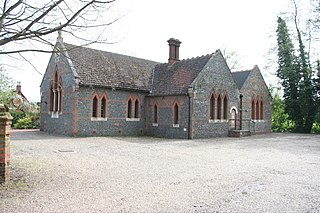
Hoxne is a village in the Mid Suffolk district of Suffolk, England, about five miles (8 km) east-southeast of Diss, Norfolk and 1⁄2 mile (800 m) south of the River Waveney. The parish is irregularly shaped, covering the villages of Hoxne, Cross Street and Heckfield Green, with a 'tongue' extending southwards to take in part of the former RAF Horham airfield.

The Cuerdale Hoard is a hoard of more than 8,600 items, including silver coins, English and Carolingian jewellery, hacksilver and ingots. It was discovered on 15 May 1840 on the southern bank of a bend of the River Ribble, in an area called Cuerdale near Preston, Lancashire, England. The Cuerdale Hoard is one of the largest Viking silver hoards ever found, four times larger than its nearest rival in Britain or Ireland, according to Richard Hall. In weight and number of pieces, it is second only to the Spillings Hoard found on Gotland, Sweden.

The Hoxne Hoard is the largest hoard of late Roman silver and gold discovered in Britain, and the largest collection of gold and silver coins of the fourth and fifth centuries found anywhere within the former Roman Empire. It was found by Eric Lawes, a metal detectorist in the village of Hoxne in Suffolk, England in 1992. The hoard consists of 14,865 Roman gold, silver, and bronze coins and approximately 200 items of silver tableware and gold jewellery. The objects are now in the British Museum in London, where the most important pieces and a selection of the rest are on permanent display. In 1993, the Treasure Valuation Committee valued the hoard at £1.75 million.
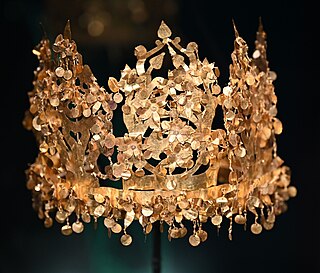
Tillya tepe, Tillia tepe or Tillā tapa is an archaeological site in the northern Afghanistan province of Jowzjan near Sheberghan, excavated in 1978 by a Soviet-Afghan team led by the Soviet archaeologist Viktor Sarianidi. The hoard found there is often known as the Bactrian gold.
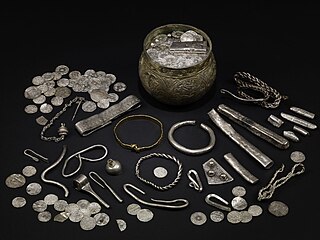
The Vale of York Hoard, also known as the Harrogate Hoard and the Vale of York Viking Hoard, is a 10th-century Viking hoard of 617 silver coins and 65 other items. It was found undisturbed in 2007 near the town of Harrogate in North Yorkshire, England. The hoard was the largest Viking one discovered in Britain since 1840, when the Cuerdale hoard was found in Lancashire, though the Anglo-Saxon Staffordshire Hoard, found in 2009, is larger.

The Broighter Gold or more correctly, the Broighter Hoard, is a hoard of gold artefacts from the Iron Age of the 1st century BC that were found in 1896 by Tom Nicholl and James Morrow on farmland near Limavady, Ireland. The hoard includes a 7-inch-long (18 cm) gold boat, a gold torc and bowl and some other jewellery.

The Dacian bracelets are bracelets associated with the ancient people known as the Dacians, a distinct branch of the Thracians. These bracelets were used as ornaments, currency, high rank insignia and votive offerings Their ornamentations consist of many elaborate regionally distinct styles. Bracelets of various types were worn by Dacians, but the most characteristic piece of their jewelry was the large multi-spiral bracelets; engraved with palmettes towards the ends and terminating in the shape of an animal head, usually that of a snake.

Hacksilver consists of fragments of cut and bent silver items that were used as bullion or as currency by weight during the Middle Ages.

The Staffordshire Hoard is the largest hoard of Anglo-Saxon gold and silver metalwork yet found. It consists of almost 4,600 items and metal fragments, amounting to a total of 5.1 kg (11 lb) of gold, 1.4 kg (3 lb) of silver and some 3,500 pieces of garnet cloisonné jewellery. It is described by the historian Cat Jarman as "possibly the finest collection of early medieval artefacts ever discovered".
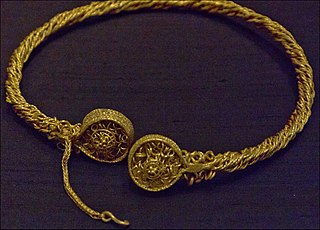
The Stirling torcs make up a hoard of four gold Iron Age torcs, a type of necklace, all of which date to between 300 and 100 BC and which were buried deliberately at some point in antiquity. They were found by a metal detectorist in a field near Blair Drummond, Perthshire, Scotland on 28 September 2009. The hoard has been described as the most significant discovery of Iron Age metalwork in Scotland and is said to be of international significance. The torcs were valued at £462,000, and after a public appeal were acquired for the National Museums of Scotland in March 2011.

The Vinkovci Treasure or Cibalae Treasure is a hoard of late Roman silver plate, discovered in Vinkovci, Croatia at the end of March 2012. Consisting of 48 artifacts weighing a total of about 36 kilograms (79 lb), the hoard includes a variety of domestic utensils and tableware, some of which is elaborately decorated with various designs and depictions. The hoard appears to have been made locally, probably in a workshop in the town, and is thought to date to the late 4th century AD. Following its discovery during construction works in the centre of Vinkovci, it was put on public display in Vinkovci and at the Museum of Arts and Crafts in Zagreb prior to a programme of conservation funded by the Croatian government.

The Canterbury Treasure is an important late Roman silver hoard found in the city of Canterbury, Kent, south-east England, ancient Durovernum Cantiacorum, in 1962, and now in the Roman Museum, Canterbury, Kent. Copies of the main items are also kept in the British Museum.
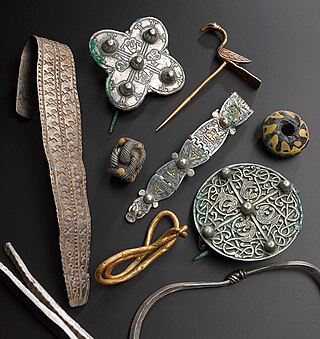
The Galloway Hoard, currently held in the National Museum of Scotland, is a hoard of more than 100 gold, silver, glass, crystal, stone, and earthen objects from the Viking Age discovered in the historical county of Kirkcudbrightshire in Dumfries and Galloway in Scotland in September 2014. Found on Church of Scotland land, the hoard has been described by experts as "one of the most significant Viking hoards ever found in Scotland". With years of extensive study and research, scholars are still not certain who buried the hoard, why they did so and whether they were Vikings or Anglo-Saxons. During the Viking Age, Galloway found itself squeezed between two Viking kingdoms and essentially cut off from other Anglo-Saxons in Britain - "Galloway is where these different cultures were meeting. It’s not just Scandinavians, but people from Britain and Ireland as well."
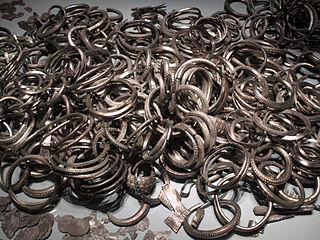
The Spillings Hoard is the world's largest Viking silver treasure, found on Friday 16 July 1999 in a field at the Spilling farm northwest of Slite, on northern Gotland, Sweden. The silver hoard consisted of two parts with a total weight of 67 kg (148 lb) before conservation and consisted of, among other things, 14,295 coins most of which were Islamic from other countries. A third deposition containing over 20 kg (44 lb) of bronze scrap-metal was also found. The three caches had been hidden under the floorboards of a Viking outhouse sometime during the 9th century.

A votive offering or votive deposit is one or more objects displayed or deposited, without the intention of recovery or use, in a sacred place for religious purposes. Such items are a feature of modern and ancient societies and are generally made to gain favor with supernatural forces.


















